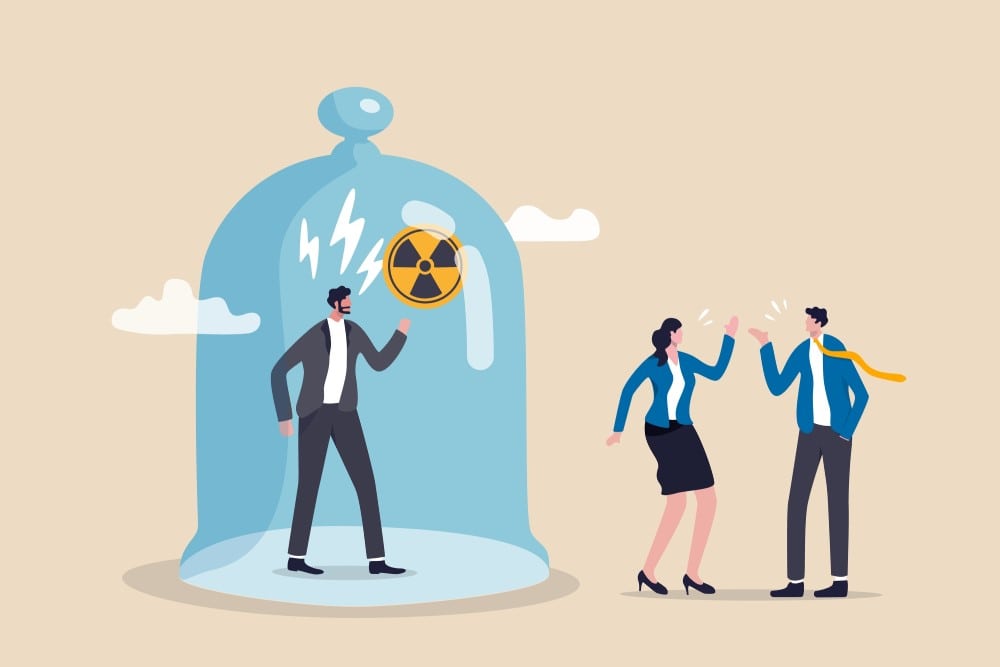What is a toxic work environment?
A toxic work environment is a negative environment in which employees do not feel comfortable. The negative atmosphere is created by colleagues, supervisors or the corporate culture itself and leads to difficulties at work and can even cause physical symptoms among employees.
In a toxic work environment, employees do not progress quickly, experience fewer successes and have less motivation. The consequences are more frequent sick leave and absenteeism, as well as economic losses for the company.
But it is not only the atmosphere that can be toxic. In the past, the term “toxic” was used to describe workplaces with certain risk factors. Carcinogens, toxic gases or vapors, and infectious specimens are also part of a toxic workplace and can lead to health problems.
Sexism and discrimination are also part of the concept of a toxic workplace.
In the 1980s, the meaning of “toxic workplace” was expanded to include workplace behaviors and regulations.

What is considered a toxic work environment?
There are several aspects that make up good working conditions. The relationship between employees, management and the CEO determines whether a work environment becomes healthy or toxic. Exposure to these aspects can have significant long-term consequences, including occupational burnout.
- Goals: in a healthy work environment, employees have clear goals and objectives. The work should be structured and the distribution of tasks should be fair and adapted to the level of training. Employees who are praised, can achieve personal goals and are encouraged to perform better than unstructured employees who are left alone.
- Values: Employees who can identify with the company’s values and goals and stand behind the guidelines perform better than employees who do not care about the company. Therefore, it is important to integrate employees into the goal-setting process.
- Role allocation: a clear hierarchy is commonplace in many companies, but not always without conflict. Respect and recognition should not be missing in any workplace – no matter in which position someone works. Clear communication helps to resolve and avoid conflicts.
- Communication: a toxic person often does not communicate at all or communicates inappropriately. Aggressive and abusive communication leads to the toxic workplace and bad mood. Always try to remain polite, calm and understandable.
- Making decisions: in a healthy workplace, team members are integrated into decision-making and the opinions of other employees are heard. Do not make decisions over the head of your co-workers and avoid authoritarian and rigid structures in your company to prevent toxic working conditions.
- Feelings: Feelings should have a place in any work environment. For mental health, it is important to be able to exchange feelings on a regular basis. It is equally important to have someone to talk to when you are not feeling well. Whether it’s a work colleague, the boss or a supervisor – feelings should be allowed to be expressed and also heard. Sharing positive feelings boosts mood and productivity, while negative feelings need to be addressed and problems solved.
- Human resources: if staff is seen as a resource, valued and treated with respect, satisfaction and willingness to perform will increase. Toxic employers who take their employees for granted deteriorate the mental and physical health of their employees. Toxic environments are the result of poor leadership.

Unclear goals and lack of transparency
Goals move a company forward. When every employee knows the company’s goals and also the smaller, individual goals, a healthy working atmosphere can develop.
A toxic work environment has no clear goals and does not support employees in their development. Thus, the development of the company also stagnates.
When employees know their contribution to the big picture, it increases their productivity and self-esteem.
Every workplace benefits from complete transparency – that way, employees agree on goals big and small, and feel like their contribution is actually making a difference.
Employers have a goal tracker that allows them to see what each individual is accomplishing, and that in turn contributes to transparency.
If individual goals are not communicated and encouraged, employees quickly feel lost on their career path and lose motivation. When employees quit their current jobs, it is often the result of a toxic work environment.
When goals and tasks do not match the level of training, workers quickly feel stressed and overworked. Feeling overworked leads to increased stress and sleepless nights. These are red flags and you should pay attention – your current workplace should improve your work life balance und well being.
Values and beliefs
Today, values and beliefs are important in any workplace culture. Healthy work environments are characterized by values that can be openly discussed and accepted.
Thus, discrimination and bullying because of sexual orientation and preferences in personal life should have no place in a healthy work environment.
In a toxic work environment, it is never really clear what makes up the corporate culture. Values and beliefs are unclear and rarely discussed.
Negative communication reinforces the sense of workplace toxicity.
Signs of a toxic work environment
Chronic stress
Are you unmotivated and tired in the morning? Do you have to force yourself to get up to go to work?Then you probably suffer from chronic stress.
According to a study, 42% of people in the U.S. suffer from chronic stress and have quit their jobs because of it.
A job that puts your employees under stress and often interferes with their time with family and friends is a sign of chronic stress. Such an unhealthy work environment should be avoided if you value a good work life balance.
You are overworked
You’re overworked if you feel angry or unhappy at work more often than usual, have sweaty palms or some other serious disruptions.
One study found out, that 43% of workers feel highly overworked. When workers are in a hostile workplace, they are usually overwhelmed with their tasks.
Overwork can lead to severe burnout and personal problems. Regular feedback, communication and off hours are important to improve this hostile work environment, enhance the well being and your work life balance.
Workplace bullying
Yes, workplace bullying is a real problem that many workers face, but it is increasingly going untreated. In most cases, 61 percent of bullies are supervisors, and 33 percent of bullies are peers.
If your employees feel burdened, scared and threatened at work, your workplace likely has a toxic culture.
Toxic employees often have toxic behavior and establish a toxic culture in your office enviroment. Self esteem and employee engagement take a back seat when employees do not feel comfortable.
If one person ignores core values and leads with bad behavior, it is the responsibility of all other employees to stop this behavior and not follow him.

Gossip in the office
When people gossip in the office, it’s a sign of a toxic culture. Rumors spread everywhere, whether intentionally or unintentionally.
You either become a victim or an accessory to office gossip. Negative communication among workers negatively impacts peer relationships and teamwork, leading to malicious behavior.
No matter which side you are on, gossip only poisons the work environment. Especially as a beginner or career changer in a new job, it can be hard to make connections.
This makes it all the more important to be treated respectfully by colleagues and to avoid bad bosses, low morale and signs of a toxic work life.
Your boss is hot-headed
Being a good boss is essential to a happy workforce. While bad managers cause high turnover, good managers boost morale and are honored on National Boss Day.
Toxic managers can poison the workplace and make it unbearable. Someone who constantly hurts your self esteem and confidence and questions your abilities is a toxic manager.
Such managers completely misunderstand the concept of leadership, and this leads to a toxic work environment.
When you are looking for a new job and see that kind of bad leadership, it should be part of the red flags. Listen to your gut feeling during the job search.

Human resources
Human resource primacy refers to how employees view the company’s interest in their well-being, health and satisfaction. Whether they are treated as a valued workforce or just a resource to be managed.
In a toxic workplace, appreciation is written small. Toxic employers treat their employees with disrespect, moving them from one department to the next and taking no interest in what their employees want.
Sick days and vacations are accompanied by guilty consciences because employees are made to feel that their absence is hindering the company’s progress.
Physical signs of toxic work environments
Toxic workplaces can be defined as any workplace where the work, atmosphere, toxic coworkers or any combination of these factors cause serious disruptions in the rest of life.
When the work life balance is not balanced, physical symptoms such as restlessness, sleep disturbances, headaches, etc. quickly occur. The hormonal balance is upset, one feels stressed, is aggressive more quickly, has palpitations or sweaty palms.
In addition, toxic or hostile work environments also have negative effects on relationships and friendships. Our bodies are very adept at telling us there’s a “danger” that needs to be addressed, so we need to pay attention to toxic behaviors.
In addition to the typical symptoms, there are also acknowledged illnesses such as Sick Building Syndrome, which is caused by a toxic workplace.
In this case, exposures such as stress, as well as the building itself, lead to health problems. Old buildings often still contain asbestos, which causes headaches and can lead to cancer. If there is an underground parking garage under the building, excessive CO pollution occurs during peak hours, which can also lead to headaches, difficulty concentrating and nausea.
Check yourself regularly with these questions:
- How are you sleeping? Are you getting at least eight hours of sleep on a regular basis?
- How are you doing with food? Are you often too stressed to eat, or do you tend to overeat?
- Do you feel safe at home and at work?
If the answers to these questions make you sit up and take notice, it’s time to review your work and office environment to determine what exactly is affecting your health and well-being. Communicate issues with your employer to find a solution and improve you situation.

Red Flags in a Job Interview
There are phrases and situations in your job search that give you a queasy gut feeling. You should trust that gut feeling and reconsider your decisions on the following aspects to avoid ending up in toxic work environments.
Pay attention to these points when interviewing for a job:
- If you’ve seen the company’s job ads before, ask them why they’re looking for new employees so often. It doesn’t have to be because of the toxic workplace; even companies that are expanding are often looking for new employees.
- The hiring process is moving too fast or they are letting you flounder.
- The recruiters/employers seem distant and indifferent. They ask very little about you, your ambitions and plans, focusing mainly on what you have already accomplished and what you can do for them. The likelihood of not achieving your own goals under such leadership is relatively high.
- The recruiter/employer does not give the impression that they are trying to make the job palatable to you. It seems like they would be satisfied either way. This is a sign of a disinterested workplace that doesn’t care about your career development at all.
- Recruiters/employers keep reminding you that numerous applicants have applied for the same job. This is a tactic to make you nervous and get you to accept a low offer. Don’t be put off by such tactics and know your value.
- Recruiters/employers ask you questions that show they have no idea what your job entails. This happens a lot with programmers and developers when they are asked about different languages. In such a workplace, you probably have changed roles, don’t know what your goals are, and aren’t getting adequate feedback.
- Ask about work ethic, how overtime is handled, and common work hours. You should not be forced to work overtime by manipulating your conscience.
- Recruiters/employers avoid answering questions about hours, promotions, or advancement opportunities. There are no set advancement opportunities, and promotions and bonuses are offered spontaneously and without structure. Expect a workplace where you will likely have to chase the employer to get recognition for your performance. In this regard, promotions and even verbal recognition can lead to increased performance and motivation. Don’t do without them!
How to fix or improve a toxic work environment?
Once you’ve identified the signs of a burnout work culture, you need to act and fix the problems in your company. Here you can read some ways to deal with toxic employees and reduce high turnover rates.
Acknowledge the problem
Once you have identified the problem, you need to address it with honesty and openness with your employees. Open communication is very important to building trust and fixing problems.
As a leader or manager, discuss with your employees what is wrong and eliminate the negative communication between them. You need to assure your employees that you will work to eliminate the problematic work environment.
Thus, you will increase the satisfaction and the employee engagement.
Specific expectations
It must be clearly communicated that your company will not tolerate discrimination, office gossip or exclusion of employees. There must be an expectation that changes will be made, and your employees must be diligent and respectful of those changes in the office environment.
Negative issues that impact the workplace must be named, and remediation of such issues is necessary. Only in this way will you manage to improve workplace toxicity and create a pleasant office environment with happy team members.
Rewards and Recognition
Employees become toxic when they feel that management and leaders do not recognize their work and efforts. No one likes poor leadership.
Implementing a fair rewards and recognition program will help employees be more productive, positive and loyal. Make your employees feel wanted and not underappreciated or overworked. This will also show up in your employees’ work life balance.
Work-life balance
A good work-life balance can help improve the work environment and eliminate toxicity. When your employees are stressed and depressed, it affects their physical health and personal lives. Create pleasant working conditions to prevent high turnover. Flexible work schedules, fewer work days, paid vacations encourage employees to maintain a work-life balance.
This will improve the office environment and their relationships inside and outside the workplace and contribute to a positive work climate.
Diversity and inclusion
Encourage teamwork instead of nepotism and politics in your workplace. A strict diversity and inclusion policy promotes positivity, unity and trust among workers.
In toxic workplaces, workers often experience discrimination or bullying based on race, color, gender, sexuality, etc. Such harmful practices increase job dissatisfaction and turnover among workers and lead to a toxic work environment. This toxic behavior must be prevented.
Mutual respect, without judgment, will therefore lead to a positive work environment. If the toxic work environment is not changed, employees will look for a new job
How to deal with a toxic work environment
Since it takes time to find a new job and you can’t just leave this difficult situation and the bad leadership behind immediately, it’s helpful to find ways to deal with the disruptions until you can start a new job:
You are not alone
Find people who are feeling the same way you are. Make friends with people who feel the same way you do. The hope is that you will have each other’s backs and share any news with the group. Don’t think it’s just you. Often, multiple employees have issues with a toxic co-worker. The toxic one makes everyone else feel like they are the problem.
Relieve stress
Do something after work that will help you relieve stress. Go to the gym, fix up your house, or learn a new skill. Most importantly, have a fulfilling life outside of work. This way, you can escape the toxic environment and the workplace toxicity, at least for a short time.
Create some lists
Create lists to keep yourself busy. A list can help you focus on your tasks instead of the toxic environment and give many employees a reason to keep going each day. Find small goals and challenges that you can master. The sense of accomplishment will mitigate some of the bad vibes of a toxic work environment.
Documentation is everything
Document everything you do. Keep emails and note comments and decisions from meetings, phone calls, and anyone who deals with you. If you need to file a grievance, you’ll need the evidence to support your claim.
Exit strategy
Begin your exit strategy. It is possible that the situation at toxic workplaces will improve, in which case it might make sense to stay. However, while you are waiting, start looking for a new job. This will help you stay positive when things get tough. If you had to leave yesterday, consider a bridge job that will keep you active while you find something that suits your career. Look for a job with high employee satisfaction, appropriate core values and no high turnover.
Note:
Knowing the telltale signs of a toxic workplace and how to deal with them will help you take the next step on your terms, so that your next job is one you truly enjoy working at, with higher ups and a special status of every employee, good managers and transparent communication.
Balance the bad with the good
Work on your self-care. If all you do is stress at work and then come home and ruminate about the day’s events, it will only add up. Devote more time to your hobbies and interests, or spend more time with family. Here are some ideas for boosting your mental health:
- Avoid working overtime
- Plan positive events during the week to look forward to
- Avoid multitasking
- Take time for yourself (e.g., wellness, walks, sports)
- Relax in the evening with a nice book or your favorite music
- Take time for extensive baths or showers
- Write a diary with your thoughts and feelings
There are many more tips, because self-care varies from person to person. Find out which small self-care activities work best for you and start doing them regularly.
NOTE: Take care of your health! Avoid stress compensation by bingeing or overeating. Substances that are harmful to your health are not likely to solve your problems.
Summary
Toxicity in the workplace is more common than ever. Whether overt or subtle, it causes physical and emotional stress for employees, but also costs employers money through lost productivity and sick leave.
To combat it, you need a cool head, a supportive environment of family, friends and allies in the workplace, as well as cooperating colleagues and bosses.
As individuals, we can’t make an entire company a better place, but you can at least learn to take care of yourself and make sure our well-being stays intact. In the case of bullying, it often helps just to have one person lead the way and take action against it.
Don’t let toxic environments drag you down. Keep your goals in mind and don’t forget your value!
Companies with rigid structures and without transparency have more often toxic working conditions than companies with open communication possibilities and flat hierarchies.
From the beginning, look for a workplace where employees are satisfied and integrated into the design of the work process.




